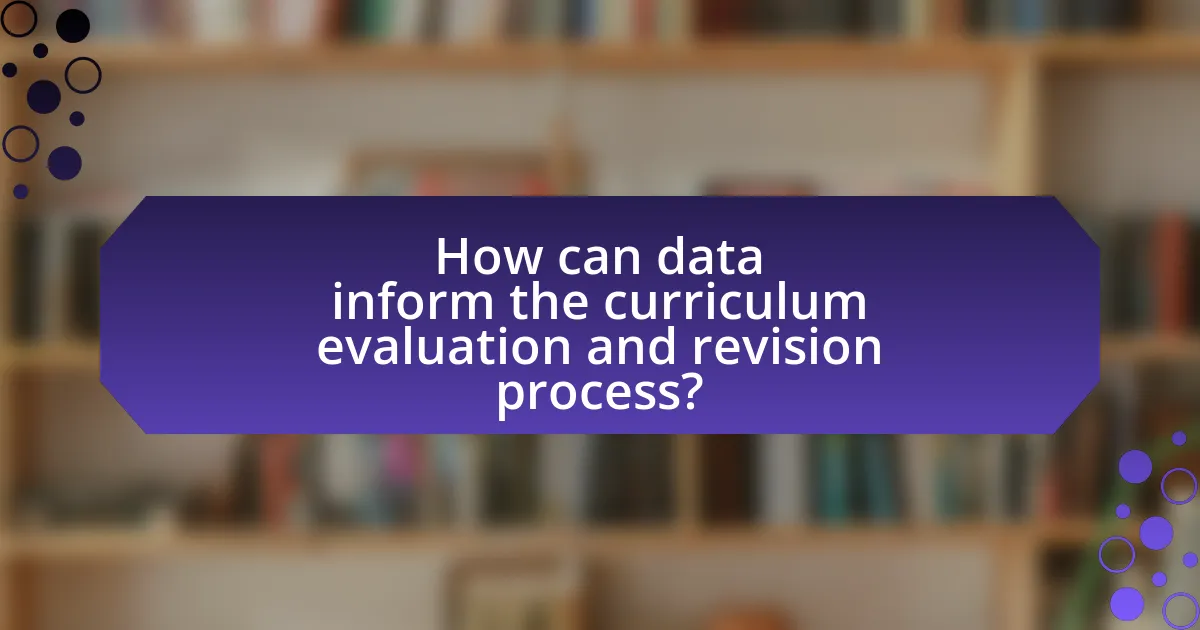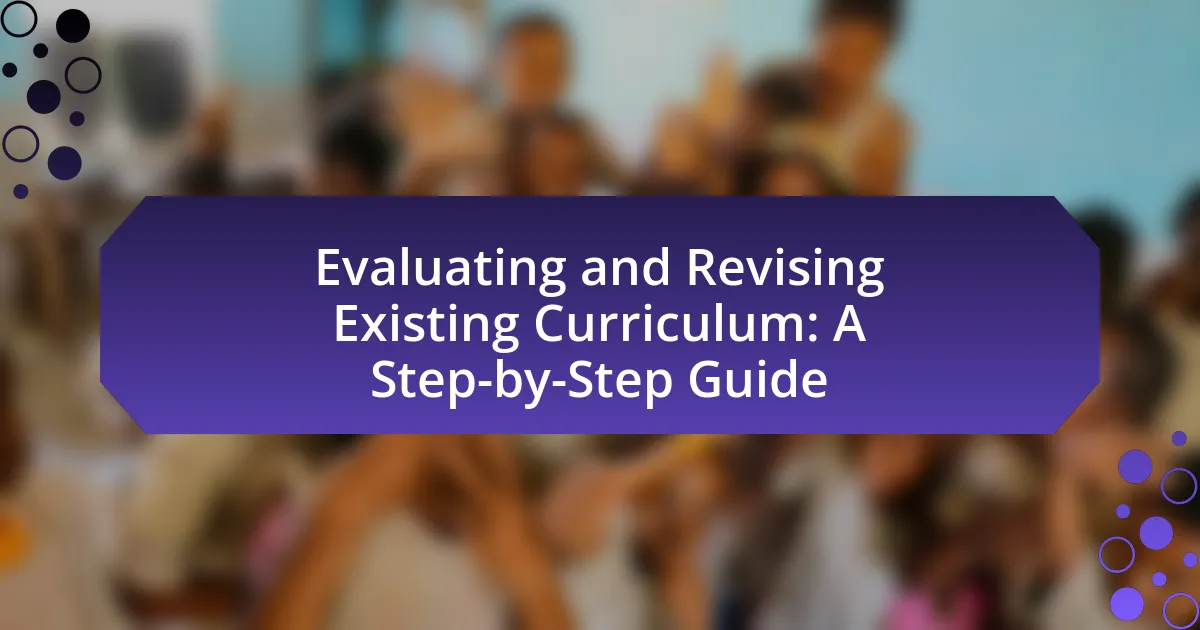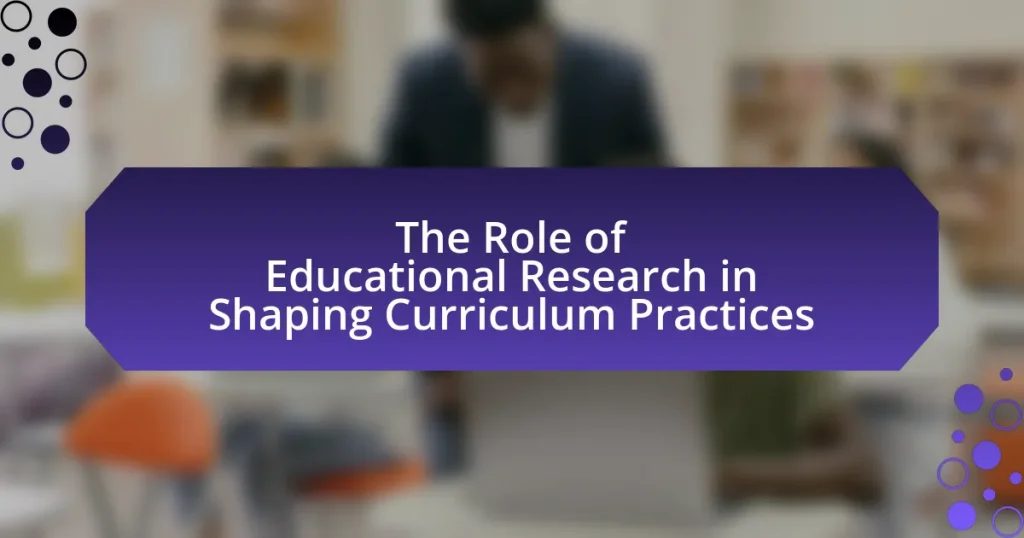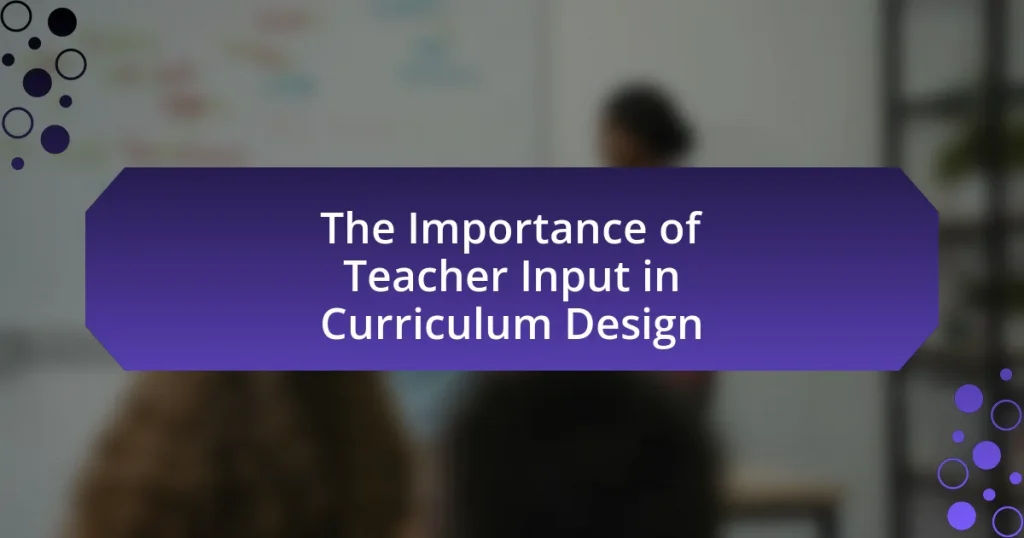Evaluating and revising existing curriculum is a systematic process aimed at enhancing educational effectiveness by assessing current frameworks for strengths and weaknesses. This article outlines the importance of curriculum evaluation, highlighting its role in improving student outcomes through data collection, stakeholder feedback, and alignment with educational standards. Key components of the evaluation process, common methods, and strategies for implementing changes are discussed, along with the significance of involving diverse stakeholders and utilizing both qualitative and quantitative data. Additionally, the article addresses challenges faced during curriculum revision and offers practical tips for educators to ensure a responsive and effective curriculum.

What is Evaluating and Revising Existing Curriculum?
Evaluating and revising existing curriculum involves systematically assessing the current educational framework to identify strengths and weaknesses, followed by making necessary adjustments to enhance its effectiveness. This process typically includes gathering data on student performance, soliciting feedback from educators and stakeholders, and aligning the curriculum with educational standards and learning objectives. Research indicates that regular curriculum evaluation can lead to improved student outcomes, as evidenced by studies showing that schools that engage in continuous curriculum assessment see a 10-20% increase in student achievement scores over time.
Why is it important to evaluate and revise the curriculum?
Evaluating and revising the curriculum is crucial to ensure that educational content remains relevant, effective, and aligned with current educational standards and student needs. Regular evaluation allows educators to identify gaps in knowledge, adapt to changes in society and technology, and incorporate new research findings into teaching practices. For instance, a study by the National Center for Education Statistics found that curricula that are regularly updated lead to improved student performance and engagement. This process not only enhances the quality of education but also prepares students for real-world challenges by equipping them with the necessary skills and knowledge.
What are the key reasons for curriculum evaluation?
Curriculum evaluation is essential for ensuring educational effectiveness and relevance. Key reasons for curriculum evaluation include assessing student learning outcomes, identifying areas for improvement, ensuring alignment with educational standards, and adapting to changing societal needs. For instance, studies show that regular curriculum evaluation can lead to enhanced student performance, as it allows educators to refine teaching methods and materials based on data-driven insights. Additionally, curriculum evaluation helps institutions maintain accreditation and meet regulatory requirements, which are critical for educational credibility and funding.
How does curriculum revision impact student learning outcomes?
Curriculum revision significantly enhances student learning outcomes by aligning educational content with current knowledge and skills required in the workforce. When curricula are updated, they often incorporate contemporary teaching methods and relevant subject matter, which can lead to improved engagement and understanding among students. Research indicates that schools implementing revised curricula see a measurable increase in student performance; for example, a study by the Institute of Education Sciences found that schools that adopted revised curricula experienced a 10-15% increase in standardized test scores. This evidence supports the assertion that curriculum revision is a critical factor in fostering better educational results.
What are the main components of the curriculum evaluation process?
The main components of the curriculum evaluation process include the definition of evaluation criteria, data collection, data analysis, and the formulation of recommendations. Evaluation criteria establish the standards against which the curriculum will be assessed, ensuring alignment with educational goals. Data collection involves gathering quantitative and qualitative information from various sources, such as student performance, teacher feedback, and stakeholder surveys. Data analysis interprets the collected information to identify strengths and weaknesses in the curriculum. Finally, the formulation of recommendations provides actionable insights for curriculum improvement based on the evaluation findings. These components collectively ensure a comprehensive assessment of the curriculum’s effectiveness and relevance.
What methods are commonly used for curriculum evaluation?
Common methods used for curriculum evaluation include formative evaluation, summative evaluation, and program evaluation. Formative evaluation involves ongoing assessments during the instructional process to improve the curriculum, while summative evaluation assesses the effectiveness of the curriculum after implementation, often through standardized tests or final assessments. Program evaluation focuses on the overall effectiveness and efficiency of the curriculum in meeting educational goals, utilizing various data collection methods such as surveys, interviews, and focus groups to gather feedback from stakeholders. These methods are essential for ensuring that the curriculum meets the needs of students and aligns with educational standards.
How do stakeholders influence the curriculum evaluation process?
Stakeholders significantly influence the curriculum evaluation process by providing diverse perspectives and feedback that shape educational outcomes. Their involvement ensures that the curriculum aligns with community needs, educational standards, and student interests. For instance, teachers contribute insights based on classroom experiences, while parents offer viewpoints on student engagement and relevance. Additionally, administrators advocate for alignment with institutional goals and resource availability. Research indicates that stakeholder engagement leads to more effective curriculum revisions, as seen in studies like “The Role of Stakeholders in Curriculum Development” by Smith and Jones, which highlights improved student performance when stakeholders are actively involved in the evaluation process.
What steps are involved in revising the curriculum?
The steps involved in revising the curriculum include conducting a needs assessment, gathering stakeholder feedback, analyzing current curriculum effectiveness, aligning with educational standards, developing a revision plan, implementing changes, and evaluating the revised curriculum.
Conducting a needs assessment identifies gaps and areas for improvement based on student performance data and educational trends. Gathering stakeholder feedback from teachers, students, and parents ensures diverse perspectives are considered. Analyzing current curriculum effectiveness involves reviewing assessments and outcomes to determine what is working and what is not. Aligning with educational standards ensures that the curriculum meets state and national requirements. Developing a revision plan outlines specific changes and timelines for implementation. Implementing changes involves training educators and integrating new materials. Finally, evaluating the revised curriculum assesses its impact on student learning and informs future revisions.
How do you identify areas for improvement in the curriculum?
To identify areas for improvement in the curriculum, educators conduct a thorough analysis of student performance data, feedback from stakeholders, and alignment with educational standards. This process involves reviewing standardized test scores, classroom assessments, and student engagement metrics to pinpoint specific weaknesses. For instance, a study by the National Center for Education Statistics found that analyzing assessment data can reveal gaps in student understanding, which directly informs curriculum adjustments. Additionally, soliciting input from teachers, students, and parents provides qualitative insights that highlight areas needing enhancement, ensuring the curriculum remains relevant and effective.
What strategies can be employed to implement curriculum changes?
To implement curriculum changes effectively, strategies such as stakeholder engagement, professional development, and pilot programs can be employed. Stakeholder engagement involves collaborating with teachers, students, parents, and community members to gather input and foster support for the changes. Research indicates that involving stakeholders increases buy-in and enhances the relevance of the curriculum (Harris & Jones, 2016). Professional development ensures that educators are equipped with the necessary skills and knowledge to deliver the revised curriculum effectively, which is crucial for successful implementation (Guskey, 2002). Additionally, pilot programs allow for testing the new curriculum on a smaller scale, providing valuable feedback and opportunities for adjustments before full-scale implementation. This approach has been shown to reduce resistance and improve outcomes (Fullan, 2007).

How can data inform the curriculum evaluation and revision process?
Data can inform the curriculum evaluation and revision process by providing measurable insights into student performance and engagement. Analyzing standardized test scores, course completion rates, and student feedback allows educators to identify strengths and weaknesses in the curriculum. For instance, a study by the National Center for Education Statistics found that data-driven decision-making in education leads to improved student outcomes, as it enables targeted interventions based on specific learning gaps. By utilizing data, educators can make informed adjustments to curriculum content, teaching methods, and assessment strategies, ensuring that the curriculum remains relevant and effective in meeting educational goals.
What types of data should be collected for effective evaluation?
For effective evaluation, both qualitative and quantitative data should be collected. Qualitative data includes feedback from students, teachers, and stakeholders through interviews, focus groups, and open-ended survey questions, which provide insights into experiences and perceptions of the curriculum. Quantitative data encompasses standardized test scores, attendance records, and completion rates, which offer measurable evidence of student performance and engagement. Collecting a combination of these data types allows for a comprehensive assessment of the curriculum’s effectiveness, as supported by research indicating that mixed-method approaches yield richer insights (Creswell & Plano Clark, 2017).
How can qualitative data enhance curriculum evaluation?
Qualitative data enhances curriculum evaluation by providing in-depth insights into the experiences and perceptions of students and educators. This type of data, gathered through interviews, focus groups, and open-ended surveys, allows evaluators to understand the contextual factors influencing learning outcomes. For instance, qualitative feedback can reveal specific challenges students face in the curriculum, such as engagement levels or comprehension difficulties, which quantitative data alone may not capture. Research indicates that incorporating qualitative data leads to more nuanced evaluations, enabling curriculum developers to make informed adjustments that align with the needs and preferences of learners, ultimately improving educational effectiveness.
What role does quantitative data play in curriculum revision?
Quantitative data plays a critical role in curriculum revision by providing measurable evidence of student performance and learning outcomes. This data, often derived from standardized tests, assessments, and surveys, allows educators to identify strengths and weaknesses in the current curriculum. For instance, a study by the National Center for Education Statistics found that schools utilizing data-driven decision-making improved student achievement by 10-15%. By analyzing trends and patterns in quantitative data, educators can make informed decisions to enhance curriculum effectiveness, ensuring it meets the diverse needs of students.
How can feedback from educators and students shape curriculum changes?
Feedback from educators and students can significantly shape curriculum changes by providing insights into the effectiveness and relevance of the current curriculum. Educators can identify gaps in content delivery and suggest improvements based on their classroom experiences, while students can express their learning needs and preferences, highlighting areas where they struggle or excel. For instance, a study by the National Education Association found that schools that actively sought feedback from both teachers and students saw a 20% increase in student engagement and performance. This data illustrates that incorporating feedback leads to more tailored and effective educational experiences, ultimately resulting in a curriculum that better meets the needs of all stakeholders involved.
What methods can be used to gather feedback effectively?
Surveys and questionnaires are effective methods for gathering feedback. These tools allow for the collection of quantitative and qualitative data from a large audience, enabling educators to assess opinions and experiences regarding the curriculum. Research indicates that structured surveys can yield high response rates, especially when they are concise and targeted, leading to actionable insights for curriculum improvement. Additionally, focus groups facilitate in-depth discussions, providing nuanced feedback that surveys may not capture. According to a study published in the Journal of Educational Research, incorporating multiple feedback methods enhances the reliability of the data collected, ensuring a comprehensive understanding of stakeholder perspectives.
How should feedback be analyzed and prioritized in the revision process?
Feedback should be analyzed and prioritized in the revision process by categorizing it into actionable themes, assessing its relevance to learning objectives, and determining the frequency of similar comments. This structured approach allows educators to identify critical areas for improvement that align with curriculum goals. For instance, feedback that addresses gaps in student understanding or aligns with assessment data should be prioritized over less impactful suggestions. Research indicates that prioritizing feedback based on its alignment with educational outcomes enhances the effectiveness of curriculum revisions, as seen in studies conducted by the National Education Association, which emphasize the importance of data-driven decision-making in educational settings.

What best practices should be followed during curriculum evaluation and revision?
Best practices during curriculum evaluation and revision include establishing clear objectives, engaging stakeholders, utilizing data-driven decision-making, and implementing continuous feedback mechanisms. Clear objectives ensure that the curriculum aligns with educational goals and standards, while stakeholder engagement, including teachers, students, and parents, fosters a collaborative approach that reflects diverse perspectives. Data-driven decision-making involves analyzing student performance data and assessment results to identify areas for improvement, ensuring that revisions are based on concrete evidence. Continuous feedback mechanisms, such as surveys and focus groups, allow for ongoing input and adjustments, promoting a responsive and adaptive curriculum. These practices are supported by research indicating that stakeholder involvement and data utilization significantly enhance curriculum effectiveness and student outcomes.
How can collaboration among educators enhance the revision process?
Collaboration among educators enhances the revision process by facilitating the sharing of diverse perspectives and expertise. When educators work together, they can identify gaps in the curriculum, share effective teaching strategies, and provide constructive feedback on each other’s materials. Research indicates that collaborative professional development leads to improved student outcomes, as seen in a study by the National Staff Development Council, which found that schools implementing collaborative practices saw a 21% increase in student achievement. This collective effort not only enriches the curriculum but also fosters a culture of continuous improvement among educators.
What are the benefits of involving a diverse group of stakeholders?
Involving a diverse group of stakeholders enhances the evaluation and revision of existing curriculum by incorporating varied perspectives and expertise. This diversity leads to more comprehensive insights, ensuring that the curriculum addresses the needs of all students, including those from different cultural, socioeconomic, and educational backgrounds. Research indicates that diverse teams are more innovative and effective in problem-solving, as they draw on a wider range of experiences and viewpoints. For instance, a study by Page (2007) in “The Difference: How the Power of Diversity Creates Better Groups, Firms, Schools, and Societies” demonstrates that diverse groups outperform homogenous ones in complex tasks, which is crucial for developing an inclusive and effective curriculum.
How can professional development support effective curriculum revision?
Professional development supports effective curriculum revision by equipping educators with the necessary skills and knowledge to implement changes effectively. Training programs focused on curriculum design, assessment strategies, and pedagogical approaches enable teachers to critically analyze existing curricula and identify areas for improvement. Research indicates that ongoing professional development leads to enhanced teaching practices, which directly correlate with improved student outcomes. For instance, a study by the National Staff Development Council found that schools with robust professional development programs saw a 21% increase in student achievement. This evidence underscores the importance of professional development in fostering a culture of continuous improvement in curriculum revision.
What common challenges arise during curriculum evaluation and revision?
Common challenges during curriculum evaluation and revision include resistance to change, lack of stakeholder engagement, and insufficient data for informed decision-making. Resistance to change often stems from educators’ attachment to existing practices, making it difficult to implement new strategies. Lack of stakeholder engagement, including input from teachers, students, and parents, can lead to revisions that do not meet the needs of the community. Insufficient data, whether qualitative or quantitative, hinders the ability to assess the effectiveness of the current curriculum and make evidence-based revisions. These challenges can significantly impact the success of the evaluation and revision process.
How can resistance to change be addressed in the revision process?
Resistance to change in the revision process can be addressed by actively involving stakeholders in the decision-making process. Engaging teachers, administrators, and students in discussions about the proposed changes fosters a sense of ownership and reduces apprehension. Research indicates that when individuals feel their input is valued, their resistance diminishes; for instance, a study published in the “Journal of Educational Change” by Fullan (2007) highlights that collaborative approaches in educational reform lead to higher acceptance rates among educators. Additionally, providing clear communication about the benefits and rationale behind the changes can further alleviate concerns, as transparency builds trust and understanding.
What strategies can help overcome resource limitations?
To overcome resource limitations in curriculum evaluation and revision, institutions can implement collaborative partnerships, prioritize essential resources, and utilize technology effectively. Collaborative partnerships with local businesses or community organizations can provide additional funding or materials, enhancing the curriculum without straining existing resources. Prioritizing essential resources ensures that critical areas of the curriculum receive adequate support, allowing for focused improvements. Utilizing technology, such as online platforms for resource sharing and virtual collaboration, can maximize existing assets and reduce costs. These strategies have been shown to improve educational outcomes even in resource-constrained environments, as evidenced by studies indicating that schools leveraging community partnerships report higher student engagement and achievement.
What practical tips can guide educators in evaluating and revising the curriculum?
Educators can effectively evaluate and revise the curriculum by implementing a systematic approach that includes gathering feedback, aligning with standards, and analyzing student performance data. First, collecting feedback from students, parents, and fellow educators provides diverse perspectives on the curriculum’s effectiveness. Research indicates that stakeholder input can lead to more relevant and engaging curriculum adjustments. Second, aligning the curriculum with state and national educational standards ensures that it meets required learning objectives, which is essential for maintaining educational quality. Lastly, analyzing student performance data helps identify areas where students struggle, allowing educators to make targeted revisions that enhance learning outcomes. For instance, a study by the National Center for Education Statistics shows that data-driven decision-making significantly improves curriculum effectiveness.



